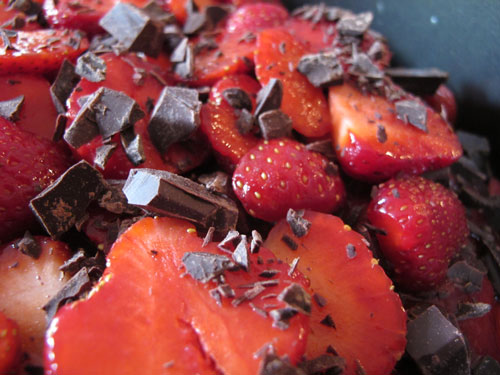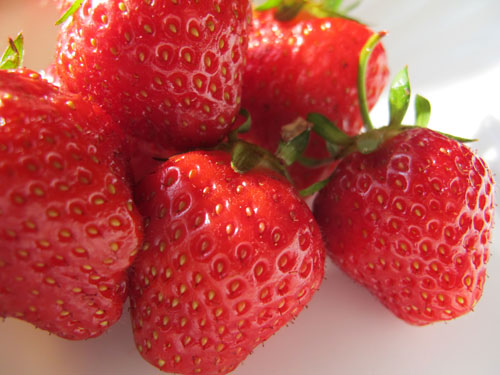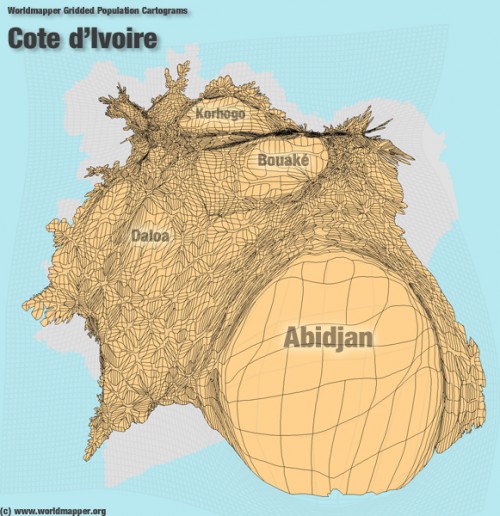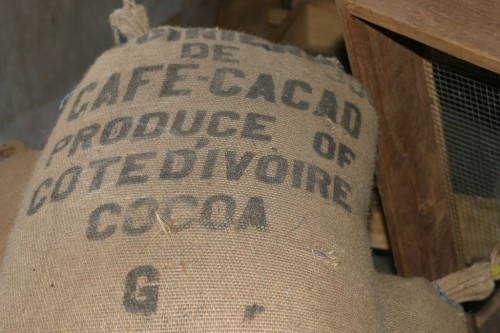Chocolate Recipe: No-Bake Strawberry Pie with Dark Chocolate Chunks and Pecan Crumble Crust
It’s the tail end of strawberry season here in New England, one of my absolute favorite times of the year. The season is fleeting. The first local strawberries appear in early June, with crops peaking mid-month, then gradually tapering off as the 4th of July holiday weekend approaches. Growing strawberries is hard work, and almost before you know it, they’re gone, and summer crops are in full swing.
During late spring and early summer visits to local farmers markets only recently reopened for the growing season, strawberries are one of the first bright spots of color in a sea of hardy leafy greens. They play a part in bringing the New England area fully back to life, with countless strawberry-related activities: strawberry plant sales at garden stores, pick your own days and festivals at local farms, and the always delicious Mass Farmers Markets Strawberry Dessert Festival.
This year, we are especially lucky to have enjoyed the large and tasty local crop. The weather has not cooperated by following any sort of pattern (although really, what else is new?); rather it has been a study in extremes – a mixture of chilly, rainy days with sweltering heat and sun. We’ve sort of stumbled into summer, but thankfully the fragile fruit made it along with us in all its sweet, juicy glory.
On Saturday, a group of friends and I made our way to the Verrill Farm Strawberry Festival in Concord, Massachusetts. It was another gray, drizzly day in a week of grayer, drizzlier days, and just warm enough to make everything feel sort of sticky. A number of rugged folks picked their own in raincoats and mud boots, sloshing through the mucky fields to find the best berries. We were landlubbers and enjoyed the festival on solid ground, partaking of the fantastic strawberry shortcake made on site (strawberries served with a buttery biscuit and real whipped cream, the classic New England way; biscuit recipe here [pdf]), fun music, and the excellent farm stand. The Boy and I couldn’t stop ourselves – we bought several quarts of perfectly ripe strawberries and proceeded to eat them for the rest of the weekend. Because while strawberry lovers can freeze, dry, and can the fruit to preserve as much of the early summer joy as possible, there is really nothing like eating a perfectly ripe, local strawberry, fresh from the vine. And what better to eat strawberries with than chocolate?
Here’s a simple, refreshing recipe that highlights the finest qualities of ripe, seasonal strawberries paired with dark chocolate. It’s a novel take on a classic combination.
No-Bake Strawberry Pie with Dark Chocolate Chunks and Pecan Crumble Crust
Adapted from Colleen Patrick-Goudreau’s The Joy of Vegan Baking (a must-own cookbook, in my humble opinion).
Ingredients
Crust:
- 2 C raw pecans (or almonds, if you prefer)
- 3/4 C to 1 C pitted dates
- 1/4 t salt
- canola oil cooking spray (to coat pan)
Pie filling:
- 5 C ripe strawberries
- 5 pitted dates
- 2 t fresh lemon juice
- dark chocolate chunks in a quantity of your choosing/craving
Instructions
Crust:
- Prepare an 8- or 9-inch circular tart or springform pan by very lightly coating with canola oil cooking spray.
- Grind nuts in a food processor or blender until they resemble a coarse meal.
- Add dates and salt into nut mixture, then process or blend until thoroughly combined.
- Pour mixture into pan, then press into the shape of a crust. Set pan aside.
Pie filling:
- Soak 5 pitted dates in warm water for 10 minutes, then drain water and gently dry dates on towel.
- Separate 1 C of whole strawberries and set aside.
- Slice 4 C of strawberries, then arrange sliced strawberries on the crust, reserving a small number to adorn top of pie. Set pan aside.
- Place the reserved 1 C of whole strawberries in a food processor or blender and process until pureed.
- Add soaked pitted dates and 2 t lemon juice to strawberry puree and process until smooth.
- Pour strawberry puree mixture over the sliced strawberries in the pan. Decorate the top of the pie with reserved sliced strawberries.
- Prepare chocolate chunks (I chopped up leftover bits of several different dark chocolate bars) and sprinkle over top of pie.
- Refrigerate entire pie for 1 hour before serving.
Yield: Approximately 8 servings.
Storage: This super fresh dessert is best when eaten right from the refrigerator after the 1 hour setting time. If you somehow manage to maniacally restrain yourself from finishing it, however, it can be stored in an airtight container and refrigerated overnight.
Bon appétit!
Links: Recent News in Chocolate, Culture, and the Politics of Food
Chocolate news
Cocoa shortage by 2020 unless industry acts now, warns Mars
Mars Chocolate, which currently purchases only 5 percent of its total supply from certified sustainable cocoa producers, pledged to use 100 percent certified sustainable chocolate by 2020. The company also predicted a major cocoa shortage (of more than one million tons) by that time if sustainable measures are not significantly increased. Here’s hoping that “technology transfer that puts farmers first; innovations in agricultural science; and rigorous certification standards” (Mars’ words) will be meaningful.
Ghana’s former President John Kufuor, was awarded the World Food Prize for his “zero hunger” program, which cut hunger levels in Ghana by half over his eight years in office. “His government achieved this by modernising and commercialising cocoa farming, Mr Kufuor said.”
Ferrero has received the “Golden Windbag” award for the “most misleading advertising” by a food manufacturer this year. It won the award for deceptive advertising of its Milch-Schnitte brand, sold in Germany with the slogan “Tastes light. Doesn’t weigh you down. Ideal for in between,” and portrayed in ads featuring figures from extreme sports. The awarding group, Foodwatch, argued that the advertising does not properly inform shoppers about the product’s sugar and fat content and suggests that it is instead sporty and light. Ferrero has refused to accept the award. This is not the first time that Ferrero has been accused of using misleading advertising — only a few years ago, its brand Nutella caused global uproar when it was marketed as part of a healthy breakfast for children. You can watch an Australian version of a Nutella ad advising on children’s nutrition here.
Some chocolate products and attractions that have piqued my interest of late:
Honest CocoaNova, from the folks at HonestTea. It comes in three flavors: cherry cacao, mint cacao, and mocha cacao. More here, thanks to Nashville Scene Bites blog.
Billed as “brewed chocolate,” or a chocolate drink for coffee lovers, Choffy also looks interesting. I’m excited (with a healthy side of skepticism) to try it. Just check out the branding! It is so intensely organic, green, antioxidant and theobromine rich, foreign yet single origin… the company is pushing all the right buttons for the Whole Foods crowd.
Here’s one from the “funny but sort of gross” category: Chocolate Plasticine. “Magic chocolate lets you mould, stretch and squeeze your chocolate into whatever you like.” (via MadeForMums)
Then there’s Nestle’s limited edition Alpino packaging, where the chocolates are laid out just like Peg Solitaire. It’s all fun and games until it gets eaten.
A vacation might be in order once the £2m Sweet History of York confectionery exhibit is complete.
A couple of chocolate recipes:
Chili with Chocolate from David Lebovitz
This involves dropping chocolate into the chili to melt. Yum.
Vanilla Milk with Chocolate Ice Cubes Yes, the ice cubes melt and ooze their chocolatey goodness into the milk as you drink.
(posted by thekitchn, via Le Pétrin, h/t to friend CLS for passing it on!)
Food culture and politics news
In Pictures
You don’t want fries with that
An infographic from the Washington Post displaying information from three Harvard studies on foods eaten and pounds gained or avoided. Sweets and desserts (ahem, chocolate lovers) are implicated.
Where the Farm Subsidies Go
Another informative infographic from the Washington Post.
A disturbing graphic from National Geographic on Our Dwindling Food Variety (via @NatGeo)
Artist Perrin Ireland live-draws conference sessions. This one, entitled “Scents and Sensibilities: The Invisible Language of Smell” is just fabulous. (via @sciam)
Etsy, ever the pulse of DIYers, recently posted a treasury that encapsulates the GYO (grow your own) food movement. (treasury curated by GloryBDesign)
In Words
This debate between Tomatoland author Barry Estabrook and critics presents fascinating viewpoints on American tomato growing and agriculture more generally.
A moving autobiographical portrait of journalist Jose Antonio Vargas’ life as an undocumented immigrant. Given the essential labor provided by many undocumented immigrants to US food production, this story’s critique of immigration policy is directly relevant to US food policy.
For a product like chocolate that can only be grown outside of the US, attention to FDA policies and politics is essential. What FDA is up against with imported foods, by Marion Nestle.
Just for fun
“You’re the most annoying dude I’ve ever SEEN brah…
Could you PLEASE move? You’re RIGHT in front of the Quinoa.”
Wacky (Weird Wild Wonderful Whaaaat?!) World of Choc Wednesdays
I’ve got several posts in the works right now. They will be published here over the next few weeks. Truth be told, I spend most days typing away at my dissertation (on a totally different topic, though with eerily similar theoretical underpinnings…), and after filling up those pages I’m plum outta words. Combine that with the excitement of spring and summer in New England, and there are never ending excuses for putting off blogging!
Delays, shmelays. Here’s something fun:
Each Wednesday, I plan to post something neat from our beloved wacky world of choc, something that makes me go “Whoa!” This week, I was struck by a post in Juxtapoz Magazine (also covered by HuffPost), featuring a video art piece by artist Martynka Wawrzyniak. In the video, Wawrzyniak lies face up on a white background, visible only from her shoulders to the top of her head. Over the course of a crawling, intense nine minutes and twenty two seconds, a stream of liquid chocolate pours down over her until she is submerged.
The video:
Chocolate, 2010 from MARTYNKA WAWRZYNIAK on Vimeo.
The end result:
I wish that there was a video feed to show visceral audience reactions.
HuffPost asked some great questions about the piece: “Is it gross? Is it suggestive? Is it political? Is it poignant?”
I am wondering, of course, is it about chocolate? What if, instead of chocolate it were water, or milk, or glue, or motor oil? [shudder] What do you think?
Côte d’Ivoire in Crisis – What Chocolate Lovers Can Do To Help
The current humanitarian situation in Côte d’Ivoire is dire. I’ve been watching from abroad since the fall of 2010, hunting down the occasional news article, radio broadcast, tweet, or YouTube video that has made its way into the American mediascape. At present, an estimated one million Ivorians have fled just from Abidjan, the country’s largest city and administrative center. Other citizens from all over the country find themselves similarly displaced; many have fled to neighboring Liberia as refugees. Since November 2010, fifteen hundred or more civilians have been killed as opposing military forces have battled.
Côte d’Ivoire is Sub-Saharan Africa’s eighth largest economy and fourth largest exporter of goods and the world’s most prolific cocoa bean producer. Abidjan is second to only Nigeria’s Lagos in population in the region, making it the seventh largest city on the African continent. Its struggles are already creating ripple effects throughout the region and the international chocolate industry.
How did this happen?
In November 2010, incumbent president Laurent Gbagbo was voted out of office, losing to opponent Alassane Ouattara. The country of Côte d’Ivoire had long awaited these elections, which were repeatedly delayed by the Ivorian Civil War in the early 2000s. Idealists hoped that the elections would help to unify the country, which has long been divided ethnically, religiously, and geographically (north to south). The international community sanctioned the elections and proclaimed Ouattara the winner. The vote was close and tensions were very high. Gbagbo, who has held the presidency since 2000, refused to leave, however, contesting his loss.
From the outside, it is hard not to look on Gbagbo with contempt, given what has happened in his country since November. He has stubbornly remained in the presidential palace while chaos has descended outside; most recently he has hidden with his family in a luxurious basement bunker under the palace.
From the scant news, the outside world has learned that his troops have battled those of his opponent, shot down peacefully marching women, and killed hundreds of civilians. As Gbagbo has grown more desperate over these six months, he has threatened United Nations peacekeeping forces in the country, repeatedly rebuffed attempts to negotiate a peaceful resolution to the election aftermath, and worked to nationalize banks and the massive cocoa trading sector, frantically grasping for anything that might give him profit and power. He has long been an anti-colonialist, often xenophobic leader, which, the world’s hierarchy being as it is, has most certainly contributed to the international community’s general scorn for him and his policies. Following the election, he even went so far as to hire a famous US lobbyist to help him reform his image and argue for the legality of his retention of the presidency, though this eventually backfired.
But Gbagbo is not by any means hated by all Ivorians – he’s supported by a large number of them, in fact – a reported 46% of November’s voters chose him as their leader.
Opponent Alassane Ouattara is less vilified in the media and, as the international golden boy, makes a more sympathetic character to outsiders. For many years, his opponents have threatened him and his supporters, who have long played the underdog card in Ivorian politics. Yet Ouattara himself is powerful. He achieved success by hitching Côte d’Ivoire’s economy to France’s while working with the IMF and Central Bank of West African States and served as the unelected Prime Minister from 1990-1993. He is highly educated and an old friend of French leader Nicolas Sarkozy.
Since the election, Ouattara has remained in a hotel suite under the protection of UN peacekeepers. He has insisted, with the support of the international community, that he must be inaugurated as president. However, his troops, like Gbagbo’s, have also attacked, destroyed, and killed. They have been accused of massacring a village of several hundred civilians. And it is unclear that Ouattara, even with his wide and influential international network, could have peacefully unified the country had he begun his presidency as scheduled. Now, with the country’s stability so severely disrupted and his own credibility seriously marred, he will face even more enormous challenges once he is president.
International intervention (or lack thereof)
The African Union and ECOWAS have ousted Côte d’Ivoire from their ranks and repeatedly attempted to negotiate an exit for Gbagbo. They have imposed sanctions on the country in response to his resistance. Côte d’Ivoire’s neighbors – Liberia, Guinea, Mali, Burkina Faso, and Ghana – are ill equipped to assist with refugee camps for the many displaced Ivorians seeking safety and shelter. In fact, many citizens of these neighboring countries have long sought refuge in Côte d’Ivoire.
The United States has spoken out strongly against Gbagbo and in support of Ouattara, but actions have been limited to small-scale humanitarian donations and financial sanctions on Gbagbo and his wife. US Secretary of State Hillary Clinton has repeatedly called for Gbagbo to step down and issued statements against violence. President Obama has issued similar statements and recorded a video message to the people of Côte d’Ivoire, promising that those who choose democracy will have a friend and partner in the US.
Given the enormity of the humanitarian crisis in the country, though, these efforts seem nothing more than talk – the US has yet to take any substantive actions for the welfare of Côte d’Ivoire’s citizens. You can see many of the highlights of US State Department statements here.
Unfortunately, throughout the post-election chaos in Côte d’Ivoire, Americans have been preoccupied with numerous other news stories – developments in Egypt, Wisconsin, Japan, Libya, the US House budget proposal, and Rebecca Black’s viral music video “Friday.”
As time has passed, the US, EU, and UN Security Council have placed ever more stringent sanctions on Côte d’Ivoire. Sadly, these sanctions have made little difference to Gbagbo and enormous difference to the Ivorians who must survive in severely disrupted, precarious conditions. France, Côte d’Ivoire’s wealthy former colonizer, has only this week seized the country’s main airport and placed French nationals under their protection. Given France’s intense involvement in Côte d’Ivoire’s history and current economic standing, the lack of action on behalf of Ivorian citizens is deplorable.
As I write this blog post, talks between Gbagbo’s generals and the international community over a surrender have broken down once again. Ouattara’s forces stormed the presidential palace in early April, making their way closer to Gbagbo. Now UN peacekeeping and French forces are taking the offensive to physically remove him from the property. The EU has begun loosening sanctions against the cocoa sector in anticipation of Ouattara’s presidency. Still, the outcome remains uncertain. This fighting has gone on for many months, as has the inevitable human suffering that such events cause.
Why haven’t we heard more about this?
Perhaps most maddening to an outside observer is the lack of news about Côte d’Ivoire in major media outlets. The BBC and Voice of America give semi-regular updates, though articles are often terse and cold, reading like old-timey telegraphs. Other news articles are almost sickeningly inhuman, concentrating purely on the economic effects of the country’s instability. They list statistics, use obtuse trading jargon to explain the steep rise of cocoa prices, and describe sanctions – none of them tell much about what is happening on the ground. Will there be a chocolate drought?, headlines worry. Few headlines ask: Are the people in Côte d’Ivoire alright?
Nicholas Kristof, the two-time Pulitzer Prize winning New York Times journalist, is one of the few prominent journalists to take on the inequalities in reporting and intervention. In his April 3, 2011 column, “Is It Better to Save No One?”, he writes:
Critics argue that we are inconsistent, even hypocritical, in our military interventions. After all, we intervened promptly this time in a country with oil, while we have largely ignored Ivory Coast and Darfur – not to mention Yemen, Syria and Bahrain.
We may as well plead guilty. We are inconsistent. There’s no doubt that we cherry-pick our humanitarian interventions.
But just because we allowed Rwandans or Darfuris to be massacred, does it really follow that to be consistent we should allow Libyans to be massacred as well? Isn’t it better to inconsistently save some lives than to consistently save none?
He also updated his Facebook page to include this:
People often ask why there isn’t more coverage of Syria, Ivory Coast or Yemen. One answer is something that non-journalists sometimes don’t appreciate — the difficulty of getting visas. Yemen and Syria are completely blocking Americans. Only hope to get an Ivory Coast visa is to go to Senegal and beg its embassy there. Sad truth is we systematically undercover what we don’t get access to.
Even reading these quotes for the third, fourth time, I sigh. My mouth twists with frustration. Yes, Kristof has made very important points here, he has honestly confronted some sad truths in international relations and journalism. Photojournalist Jane Hahn has also vividly described the danger that journalists face in Côte d’Ivoire. The problem of difficulty in reporting is real, but does not provide an excuse for silence. Critical, informed commentary on this situation is essential and, especially thanks to social media, much can be done to overcome travel challenges.
Life is not easy, it is rarely just, we cannot help everyone all of the time. But the entire world of chocolate is implicated in Côte d’Ivoire’s troubles, and we must do better.
What does this have to do with chocolate?
Chances are if you are an American and have eaten candy in the past thirty years, you have consumed chocolate made from Côte d’Ivoire sourced cocoa beans.
Wikipedia best explains the massive presence of Côte d’Ivoire cocoa in the world:
Côte d’Ivoire (Ivory Coast) leads the world in production and export of the cocoa beans used in the manufacture of chocolate, supplying 46% of cocoa produced in the world. West Africa, collectively supplies nearly 70% of the world’s cocoa crop, with Côte d’Ivoire leading production at 1.3 million tons, followed by neighboring Ghana with 720 thousand tons. Côte d’Ivoire overtook Ghana as the world’s leading producer of cocoa beans in 1978. Large chocolate producers such as Cadbury, Hershey’s, and Nestle buy Ivorian cocoa futures and options through Euronext whereby world prices are set.
Persistent poverty and economic instability in Côte d’Ivoire are compounded by the consistently low prices paid to the more than one million cacao farmers by large multinational corporations. Inter-ethnic strife has been stirred up by the cocoa industry there; child slavery is a lasting problem. These issues are increasingly well-documented by researchers.
For an in-depth report, see the 2007 publication “Hot Chocolate – How Cocoa fuelled the conflict in Côte d’Ivoire,” prepared by Global Witness. For a shorter, but still informative article, see the April 25, 2011 edition of The Nation, “The Roots of the Côte d’Ivoire Crisis.”
Even knowing this information, large corporations continue to buy the largest proportion of cocoa beans in Côte d’Ivoire, with little effort toward labor reform and the implementation of fair trade practices. And we continue to eat the chocolate that results.
Our sweet tooths are partially responsible for this crisis and there are things that we can do to help the people of Côte d’Ivoire.
What can you do?
Contact US lawmakers: If you are based in the US, you can contact a number of different government representatives about the situation in Côte d’Ivoire. Let them know your opinions on the situation and encourage them to take action as your elected leaders. They are able to do numerous things; perhaps most urgent now is the provision of humanitarian aid for Côte d’Ivoire’s citizens.
- Senator John Kerry (MA) is the current Chairman of the US Senate Committee on Foreign Relations. His contact information is available here.
- The Senate Foreign Relations Subcommittee on African Affairs is made up of nine senators from all over the country. Their names and contact information are available here.
- The House of Representatives Committee on Foreign Affairs, Subcommittee on Africa, Global Health, and Human Rights is made up of eight representatives from all over the country. Their names and contact information are available here.
Donate to humanitarian organizations: If you are in the US or abroad and are willing and able to donate money to humanitarian organizations working in Côte d’Ivoire, there are several to choose from. These organizations are on the ground delivering services now, and donations will ensure that they can continue to do so.
- International Red Cross
- Oxfam
- UNHCR – the UN Refugee Agency
- UNICEF – the UN Children’s Fund
- World Food Programme
Contact chocolate companies and multinational corporations: If you are in the US or abroad and are a chocolate lover who hates what is happening in Côte d’Ivoire, contact some of the multinational multibillion dollar corporations that are purchasing chocolate there. Write to them, express your opinions, insist that they answer your questions.
These corporations include, but are not limited to, Hershey, Cargill, Archer Daniels Midland, and Barry Callebaut.
You can even write to these companies and tell them what you, as a consumer, think about their codes of ethical business conduct and corporate responsibility, which they display prominently on their websites.
- Hershey’s Code of Ethical Business Conduct
- Cargill’s Corporate Responsibility Reports
- ADM’s Corporate Responsibility Update
- Barry Callebaut’s Corporate Responsibility page
Get educated: Seek out more education on the chocolate that you eat and its impact on the lives of cacao farmers. Share what you learn with your family and friends. I am still learning myself and will continue to post here. You can also follow me on Twitter and Facebook, where I routinely update with chocolate news.
Many chocolate consumers express sticker shock about the cost of chocolate that is Fair Trade or otherwise produced with attention to fair labor practices. Quite frankly, we are cheapskates about the chocolate that we eat – it has been inexpensive for a long time because we have simply not paid cacao growers appropriately (or at all – cocoa production has a long history of slave labor). Are we not devaluing other people’s lives just to save a buck on our snacks?
Overwhelmed?
I highly recommend this perspective-granting essay written by Ivorian novelist Fatou Keïta, describing her life in Abidjan over the past several days.
The Walk for Hunger
Dear readers,
I’m only able to blog about chocolate because of the privilege that has always provided me with enough food to eat. In fact, I’ve always had so much food that I’ve been able to focus attention on a non-essential, luxury food like chocolate. Yet not everyone enjoys such comfortable food security.
The Boy and I will participate in Project Bread’s The Walk for Hunger on May 1st. The 20-mile pledge walk, which has been held in Boston each year since 1969, raises funds for Project Bread’s mission to alleviate local hunger. We feel an urgency to walk now, in particular, as the House budget bill, H.R. 1, threatens to cut vital funding to the United States’ Women, Infants, and Children program, food stamp welfare programs, and international food and health aid organizations. If this bill passes, it will become even more difficult for vulnerable populations to access enough food.
Mark Bittman of the New York Times posted a heartfelt statement against this bill’s attack on access to food just yesterday evening. He writes:
“In 2010, corporate profits grew at their fastest rate since 1950, and we set records in the number of Americans on food stamps. The richest 400 Americans have more wealth than half of all American households combined, the effective tax rate on the nation’s richest people has fallen by about half in the last 20 years…. Meanwhile, roughly 45 million Americans spend a third of their posttax income on food — and still run out monthly — and one in four kids goes to bed hungry at least some of the time.”
Problems of food access hit close to home; the good news is that we can do something to help. According to Project Bread, “In Massachusetts, more than 660,000 people do not have enough food to eat. The Walk for Hunger raises millions of dollars for the 400 emergency food programs that support families in crisis.”
We will walk in memory of our loved ones, Lena Bittenson and Evan Knight Martin, whom we lost in 2010. Many of our fondest memories of food come from experiences we shared with them, from Grandma Lee’s famous split pea soup, tuna croquettes, matzoh ball soup, macaroni and cheese, and latkes, to Evan’s generous candy-sharing, beer can chicken, smoked meats, campground gourmet, and experiments in beer brewing.
Keeping in mind Grandma Lee and Evan’s wordsmithery and/or love of pirates, we have dubbed our team Pirates of the Cantabrigian. We would be grateful if you would consider making a donation to our team, or forwarding this message to others who might be interested. Donations can be made online at our team page, here. Just click “Make a Gift” below the money-meter on the right side of the page, follow the donation instructions, and then watch the treasure multiply. Arrrrrrrr! (All donations go directly to Project Bread.)
Additionally, if you are in the area and would like to join our team and walk with us, you can do so at the link above. The more food-loving donation-generating walkers, the merrier. We’d love to have your company.
We are planning a number of fun jaunts through the Boston area in order to train for “the big one” and cure our hunger over the next month. These include: a walk along the Charles River (where we will visit important historic sites of cupcake consumption); a walk to and through the Mount Auburn Cemetery (how could we justify going right by Sofra Bakery and Cafe without stopping in for a bite?); and a walk around Walden Pond, where Thoreau’s pen found inspiration (and our bellies will find joy with a picnic at Verrill Farm). Our longest training walk will see the realization of one of my long-time walking dreams – we will walk from Cambridge to my parents’ home in the ‘burbs (where of course we will need to fortify with a meal at our favorite Thai joint). Don’t worry, moms, we plan to take the back roads instead of the highway.
We love food and we hate that not everyone has enough. So we’re ready to get moving and do something about it!
With love,
Carla










